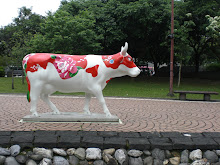Nude protest puts Taiwan on world map
Or at least, on the map of nude protests.
The reason for the protest was the Kyoto Protocol going into effect. While most of the world’s attention was focused on the United States and Australia not signing the agreement, Taiwan was never invited because it’s not a member of the United Nations. The protesters objected to some of the Taiwanese government’s less environmentally-friendly policies, such as giving approval to new petrochemical projects.
The scale and shape of the nude protest were rather modest compared to the nude anti-war or anti-fur protests of the past few years in other countries. Six male university students showed up in front of the main government building in central Taipei, undressed and put boards with protest slogans in front of the possibly offending body parts. Passersby walking or driving by probably didn’t notice much about the protest, because the small group was surrounded by a huge crowd of cameramen, photographers, journalists and some police. However, that crowd assured the protesters of exposure for their cause, because even foreign news media – including naturist web sites – paid attention to this limited protest.
Despite the modesty of the protesters, the police still went ahead and recorded footage of the action for a possible investigation whether public decency laws have been broken. To be continued, I have to write. Though of course, I hope that I won’t have to continue since the protest was just too modest to offend anyone, except perhaps the government over its industrial policies.
Returning to the topic of real naturism, just days later both of Taiwan’s evening newspapers reported the story of a restaurant in the United States organizing a monthly naturist dinner. I’m not too sure why this was news – other that a news agency had bothered to distribute a story and pictures of the event. But the news was positive in that both papers published the pictures without the usual vague spots – or “mosaics” – common in Taiwanese media pictures showing nudity.
Both those events show that tolerance of public nudity and naturism are moving forward in Taiwan, and that there is hope for naturism to become acceptable, eventually.
The reason for the protest was the Kyoto Protocol going into effect. While most of the world’s attention was focused on the United States and Australia not signing the agreement, Taiwan was never invited because it’s not a member of the United Nations. The protesters objected to some of the Taiwanese government’s less environmentally-friendly policies, such as giving approval to new petrochemical projects.
The scale and shape of the nude protest were rather modest compared to the nude anti-war or anti-fur protests of the past few years in other countries. Six male university students showed up in front of the main government building in central Taipei, undressed and put boards with protest slogans in front of the possibly offending body parts. Passersby walking or driving by probably didn’t notice much about the protest, because the small group was surrounded by a huge crowd of cameramen, photographers, journalists and some police. However, that crowd assured the protesters of exposure for their cause, because even foreign news media – including naturist web sites – paid attention to this limited protest.
Despite the modesty of the protesters, the police still went ahead and recorded footage of the action for a possible investigation whether public decency laws have been broken. To be continued, I have to write. Though of course, I hope that I won’t have to continue since the protest was just too modest to offend anyone, except perhaps the government over its industrial policies.
Returning to the topic of real naturism, just days later both of Taiwan’s evening newspapers reported the story of a restaurant in the United States organizing a monthly naturist dinner. I’m not too sure why this was news – other that a news agency had bothered to distribute a story and pictures of the event. But the news was positive in that both papers published the pictures without the usual vague spots – or “mosaics” – common in Taiwanese media pictures showing nudity.
Both those events show that tolerance of public nudity and naturism are moving forward in Taiwan, and that there is hope for naturism to become acceptable, eventually.


